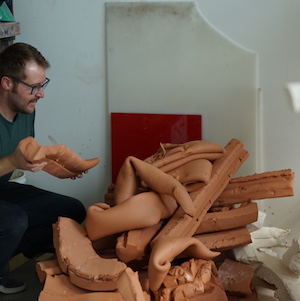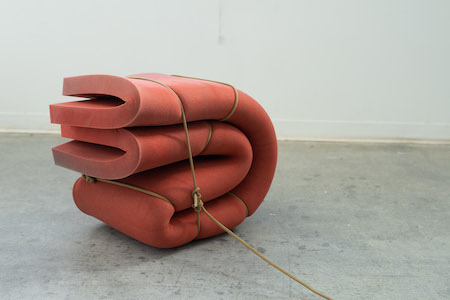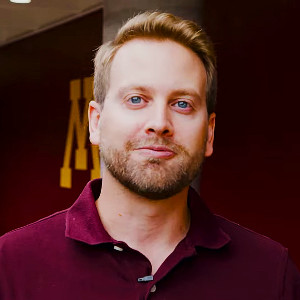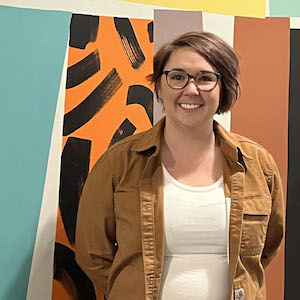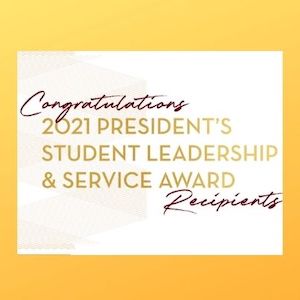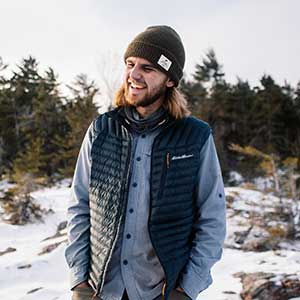An Interdisciplinary Collaboration Between an MFA Student and an Addictions Expert
What is the language of addiction? The other language, the one not found in textbooks and dictionaries. How do people with addiction truly share their experiences with a public who might not understand? For visual artists, it seems obvious and impossible at the same time.
Communicating the Abstract
Cody Hilleboe is a Master of Fine Arts candidate in the College of Liberal Arts who works in ceramics and photography. He has also recovered from an addiction to opiates. Nine years ago, he suffered a traumatic brain injury after an overdose and fell into a coma. The doctors told him to aim low, that he might not be able to drive again or finish college.
Now he is just months away from receiving his graduate degree. This semester he is collaborating with Integrated Behavioral Health and Addictions Counseling resident faculty member Emily Jordan Jensen on his thesis project, which centers on developing a visual language for his experience.
“When I came into the program I was a little ambivalent about opening up about this part of my life,” Cody says. “Working with Emily definitely helped with the comfort around that.”
The goal of his project, Cody explains, is to explore this language of addiction idea: How can I communicate some of these concepts and my experiences with people who aren't artists?
“A lot of our work was about that translation and articulation of what can be really abstract or very emotional or personal in a lot of ways,” Emily adds.
A New Kind of Directed Study
Emily was teaching the Foundations in Addiction Studies course at the time Cody approached her. “This is atypical for me,” she says. “It looks a lot different than the way my academic work and experiences often look, but I was really excited about it. I don't have any training in art therapy, but I think art is incredibly therapeutic, especially in terms of expression.”
Collaborating remotely has been a new experience for both of them. “As part of our contract,” Emily explains, “we came up with this plan for periodic studio visits, where we would get together to talk about the things Cody was reading and what he was working on… It was more just kind of meeting him where he was at in the creative process. For me it was really fun to put on more of a creative lens, too, to be a little more right-brained in the way I’m thinking about some of these things that I teach.”
For the check-ins, Cody would carry his computer around the studio to show Emily his progress.
“I was surprised at the emotional response that I had.”
– Emily Jordan Jensen
“I have a lot of intellectual thoughts about addiction and mental health," Emily says, "and this is a much different experience… a more raw or human experience in a way that was not very quantifiable.”
Traditional directed studies might be more structured and have more stringent requirements. For this project, Emily provided Cody with some resources to put addiction into context, “some reading, viewing, and literature that borrows language around how people talk about and conceptualize addiction.”
Planning for the Big Show and Beyond
In preparation for defending his thesis, Cody invited the art department and students from Emily’s introductory course to his studio for a small private exhibit.
“That was a huge step,” she says, “to open yourself and your work up to more of a general audience and to practice having open-ended conversations about what the art inspired in them.”
It was a unique experience for the ADDS 5011 students, as well, who don’t often get a chance to do cross-disciplinary work with artists.
“We have pharmacy students and social work students, but not a lot of art students collaborating with our program,” Emily says, “and I think that's a shame, and I think there's probably a lot more overlap than we think.”
The master’s candidates show will go up in May at the University of Minnesota’s Nash Gallery on the East Bank. Cody plans to display several large photographs and ceramic sculptures. His thesis committee, of which Emily is a member, will visit the gallery where Cody will explain his process and outcomes. Each student’s section will have its own title, which will provide some context for the students’ work.
“I think my art will always be rooted in addiction in some way, shape, or form.”
– Cody Hilleboe
“My ceramic work is non-objective, and my photography work is objective or representative, so I think they're going to complement each other,” Cody says.
“I think my art will always be rooted in addiction in some way, shape, or form,” he continues. “I don't think it will continue to take the same form that it's taking right now, but that is a big part of my life and will be a big part of my life.”
Artists Cody Admires
- Peter Voulkos, a ceramic artist known for his abstract expressionist sculptures, whose pieces blurred the divide between ceramic crafts and fine art
- Ken Price, a ceramicist who studied with Voulkos and is famous for his intricately painted abstract shapes
- Ron Nagel, a sculptor, musician, and songwriter who creates small yet highly textural sculptures
Resources Emily Recommends
- In the Realm of Hungry Ghosts: Close Encounters with Addiction by Gabor Mate | A holistic look at the roots and behaviors of addiction written by a medical doctor
- The Business of Drugs on Netflix
- samhsa.gov | A website for the US Department of Health’s Substance Abuse and Mental Health Services Administration
All photos courtesy of Cody Hilleboe

